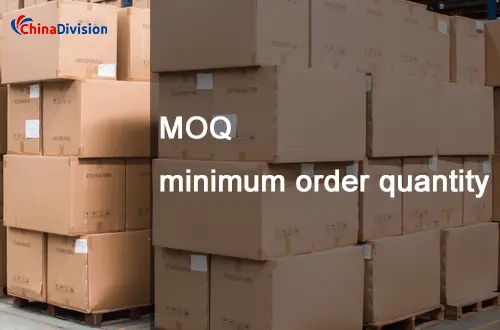What is the Impact of Moq on Inventory and E-commerce Brands
In international trade and e-commerce, the minimum order quantity (MOQ) is a common but often overlooked concept. Whether it is a B2B enterprise or an e-commerce seller, MOQ has a profound impact on procurement costs, inventory management, supply chain stability, etc. Many B2B enterprises and e-commerce sellers are often confused when they first come into contact with MOQ: Why does the supplier set MOQ? How to determine the appropriate MOQ? What is the impact of MOQ on inventory management and brand operations?
Table of Contents
- What is the minimum order quantity (MOQ)?
- Why do suppliers set minimum order quantities?
- What is the minimum order quantity (MOQ)?
- How to determine the minimum order quantity?
- What are the types of minimum order quantities?
- Advantages and Disadvantages of MOQ
- The impact of MOQ on inventory management and e-commerce brands
- Difference between MOQ and EOQ
- How does MOQ benefit suppliers and retailers?
- How to deal with the challenges of MOQ?
These issues are not only related to cost control, but also directly affect the efficiency of the supply chain and the sustainability of the business. This article will explain the relevant issues of MOQ in detail from the perspective of an international fulfillment agent service provider, and provide feasible solutions to help you be more handy in the procurement process.
What is the minimum order quantity (MOQ)?
The minimum order quantity refers to the minimum quantity that the supplier or manufacturer requires the buyer to purchase in one order. Simply put, it is the minimum quantity that the supplier requires the buyer to purchase each time in order to ensure production costs and profits. MOQ is usually set based on factors such as production costs, logistics efficiency and inventory management. MOQ is usually measured in units such as pieces, boxes, pallets, etc.

For suppliers, MOQ is an important means to ensure order profitability and production efficiency; for buyers, MOQ directly affects procurement costs and inventory pressure.
Why do suppliers set minimum order quantities?
Economies of scale
Through large-scale production, suppliers can spread fixed costs (such as equipment startup, mold costs, etc.) to more units, thereby reducing unit costs.
Reduce production costs
Producing small batch orders usually leads to higher unit costs because fixed costs (such as equipment commissioning, raw material procurement) need to be spread over fewer products.
Improve operational efficiency
Large-scale production can reduce the frequent switching of production lines, ensure smooth operation of production lines, reduce downtime, and thus improve efficiency.
Reduce inventory pressure
Suppliers can ensure the rapid turnover of products and avoid inventory backlogs through MOQ.
Screening high-quality customers
MOQ can help suppliers identify customers with long-term cooperation potential and reduce transaction costs with small-scale buyers.
Cost Management
Suppliers often buy raw materials in bulk to reduce costs, and MOQ ensures that these savings can be passed on to customers.
Quality Assurance
In large-scale production, suppliers can maintain stable processes and materials, ensuring consistency in product quality.
What is the minimum order quantity (MOQ)?
The minimum order quantity is the minimum number of units a business is willing to sell in a single order. Suppliers or manufacturers often use this value to ensure that they make a profit on each order. For example, a supplier may set the minimum order quantity to 501 units because they cannot make a profit from orders below 500 units.
How to determine the minimum order quantity?
There are multiple factors to consider when determining MOQ, including production costs, production efficiency, inventory management, market demand, and more. There is no universal MOQ calculation formula because different businesses have different needs. But demand forecasting is a crucial first step. Accurately predicting how many units you will sell helps determine a manageable MOQ. Consider factors such as product type, competition, and seasonality to estimate demand and inform your purchase orders. Here are some common methods:
Negotiation with suppliers: Communicate with suppliers to understand the reasons for setting MOQs and try to negotiate more flexible MOQs.
Market research: Rationally plan purchase quantities based on market demand and sales forecasts.
Cost analysis: Find the optimal purchase quantity by calculating order costs and inventory holding costs.
What are the types of minimum order quantities?
Determining MOQ is a process that requires balancing the interests of multiple parties. Here are several common types of MOQs and their applicable scenarios:
MOQ set by suppliers
Suppliers usually set MOQs based on their own production capacity and cost structure. For example, a clothing manufacturer may require a minimum order quantity of 500 pieces per color or size. The larger the production batch, the lower the unit cost, so suppliers tend to set higher MOQs.
MOQ set by brands
In order to maintain market positioning and brand image, some brands will actively set higher MOQs to ensure that distributors or retailers have enough inventory to meet market demand.
MOQ based on market demand
For e-commerce sellers, the setting of MOQ also needs to consider market demand and sales forecasts. Too high MOQ may lead to inventory backlog, while too low MOQ may not meet the supplier's requirements.
Advantages and Disadvantages of MOQ
Advantages:
Reduced costs: Large-volume purchases usually result in lower unit prices. MOQ ensures that the production batch is large enough to share fixed costs and reduce the production cost of a single product.
Improve supply chain stability: MOQ helps to establish long-term partnerships and ensure the stability of the supply chain.
Optimize production efficiency: Suppliers can achieve scaled production and improve efficiency through MOQ.
Profit guarantee: High MOQ helps suppliers to obtain higher profits through economies of scale.
Disadvantages:
Inventory pressure: High MOQ may lead to inventory backlog and increase warehousing costs.
Capital occupation: Large-volume purchases require more working capital, which may affect the company's cash flow.
Market risk: If market demand changes, high MOQ may cause products to be unsalable.
Reduced flexibility: Buyers may not be able to flexibly adjust order quantities due to MOQ restrictions.
The impact of MOQ on inventory management and e-commerce brands
The impact on inventory
MOQ directly affects inventory levels. High MOQ may lead to excess inventory, increase storage costs and financial pressure; while low MOQ may lead to insufficient inventory, affecting sales and customer satisfaction. High MOQ may make inventory management more complicated, requiring more detailed supply chain management to digest large purchases.
Impact on e-commerce brands
For e-commerce brands, the setting of MOQ needs to match the sales strategy. For example, emerging brands may need to test market reactions through low MOQ, while mature brands can optimize the supply chain and reduce costs through high MOQ. E-commerce sellers may need to invest a large amount of money at one time to meet MOQ, which is a challenge for sellers with weaker financial strength. High MOQ may limit sellers' flexibility, making it difficult for them to quickly adjust order quantities to adapt to market changes. E-commerce sellers need more precise inventory management to avoid inventory backlogs caused by MOQ.
Difference between MOQ and EOQ
MOQ (minimum order quantity) and EOQ (economic order quantity) are two different concepts:
MOQ is the minimum purchase quantity set by the supplier, usually based on production efficiency and cost considerations.
EOQ (Economic Order Quantity) is the optimal order quantity calculated by buyers based on inventory costs, demand forecasts, and procurement costs, aiming to minimize total costs.
In actual operations, companies need to find a balance between MOQ and EOQ to achieve cost optimization and maximize supply chain efficiency.
How does MOQ benefit suppliers and retailers?
Suppliers: By setting MOQ, suppliers can achieve economies of scale, reduce production costs, and improve production efficiency.
Retailers: Although MOQ may bring certain financial pressure, through reasonable planning and management, retailers can reduce procurement costs and improve supply chain stability.
How to deal with the challenges of MOQ? ——Solutions of international fulfillment service providers
As a professional international fulfillment service provider, ChinaDivision is well aware of the impact of MOQ on B2B companies and e-commerce sellers. We provide the following solutions to help customers deal with the challenges of MOQ:
Flexible supply chain management
We have established long-term cooperative relationships with many suppliers and can strive for lower MOQ or more flexible ordering conditions for customers.
Inventory optimization service
Through advanced inventory management systems, we help customers optimize inventory levels and avoid inventory backlogs caused by high MOQ.
Market Testing Support
For emerging brands, we provide small-batch purchasing and fast fulfillment services to help customers test market reactions and reduce trial and error costs.
Cost Sharing Program
We provide group purchasing services to allow multiple customers to share the same batch of orders, thereby reducing the MOQ pressure of a single customer. By cooperating with other buyers, joint purchasing, centralized orders to meet MOQ requirements, and sharing costs at the same time.
Customized Fulfillment Program
Based on the specific needs of customers, we provide a one-stop customized fulfillment program from procurement, warehousing to logistics to ensure that MOQ matches business goals.
Flexible Warehousing and Logistics Services
By setting up warehouses overseas, you can store goods in advance in locations close to the target market, realize local shipments, and reduce inventory pressure. According to your needs, we provide a variety of logistics channels to ensure that goods are delivered to customers quickly and safely.
Minimum Order Quantity (MOQ) is an important factor that cannot be ignored in international trade and e-commerce. By understanding the setting logic, advantages and disadvantages of MOQ and its impact on business, B2B companies and e-commerce sellers can better optimize the supply chain, control costs and improve market competitiveness.
With the help of professional international fulfillment service providers such as Chinadivision, companies can further optimize their MOQ strategies and improve the flexibility and competitiveness of their supply chains. If you encounter any problems with MOQ or international fulfillment, please contact Chinadivision. We are committed to providing customers with professional fulfillment solutions to help you succeed in the global market.





